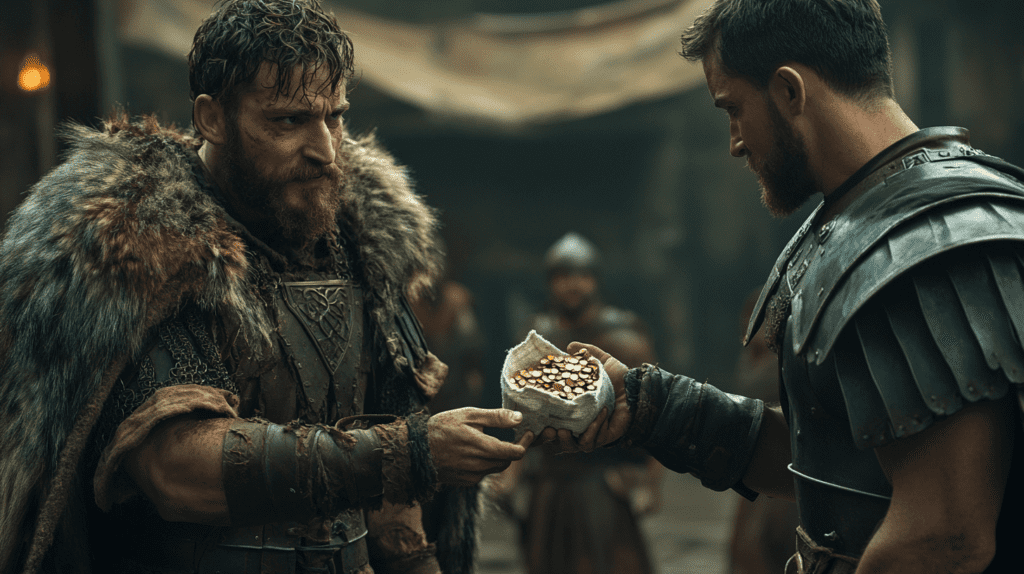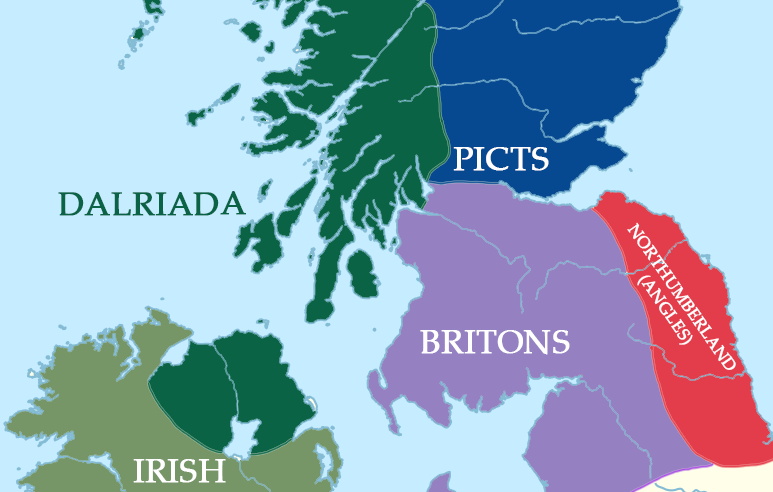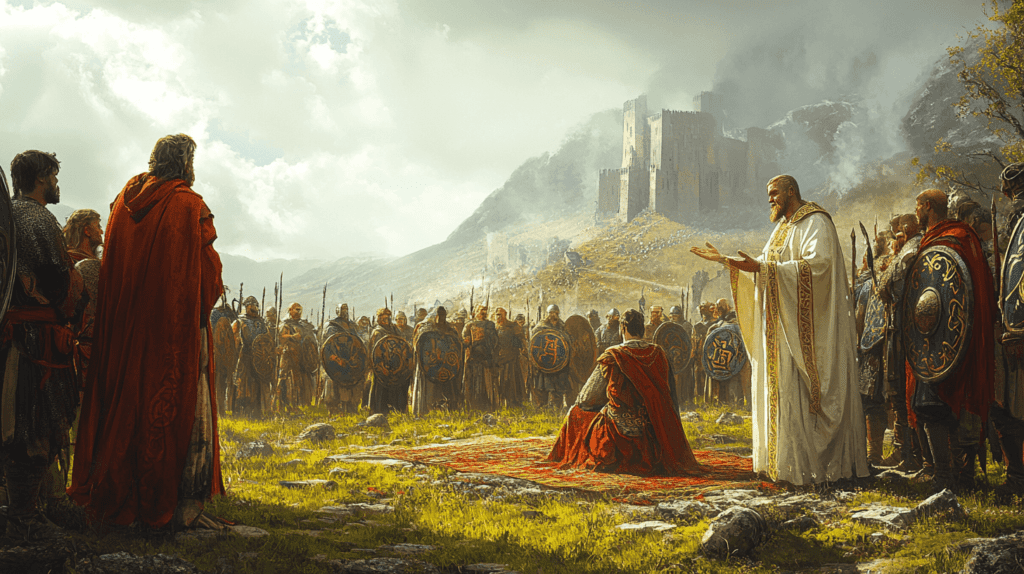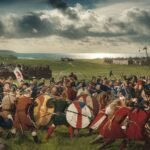
The earliest recorded use of the term “Scotti” can be found in the Nomina Provinciarum Omnium, a document dating back to around 312 AD. This brief list of Roman provinces concludes with a roster of tribes perceived as growing threats to the Empire, among which the Scotti were listed as a new designation for the Irish.
As the 4th and 5th centuries progressed, Latin writers such as Pacatus, Ammianus Marcellinus, Claudian, and the author of the Chronica Gallica of 452 began reporting periodic raids by the Scotti on the British mainland. These accounts suggest an intensification of Scotti raiding activity from the early 360s, culminating in the so-called “barbarian conspiracy” of 367–368.
The Great Conspiracy
In the winter of 367 AD, a series of seemingly coordinated attacks known as the “Great Conspiracy” struck Roman Britain. The Roman historian Ammianus Marcellinus reports that Picts, Scotti, and Saxons launched simultaneous assaults on the province. The Picts breached Hadrian’s Wall, while Attacotti and Scotti from Ireland raided the western coast, and Germanic tribes attacked from the east.
The attacks were particularly devastating due to the apparent betrayal of the miles areani, Roman intelligence agents who allegedly accepted bribes to withhold information about barbarian movements. This treachery left Roman forces unprepared for the scale and coordination of the assaults.

These incursions overwhelmed Roman defenses, leading to widespread destruction across northern and western Britannia. Towns were sacked, and many Romano-British civilians were killed or enslaved. The Roman military suffered significant losses, with Nectaridus, the coastal commander, killed and another general, Fullofaudes, either captured or besieged.
In the aftermath, loyal Roman units retreated to fortified southeastern cities, while much of the countryside fell into chaos. Deserters and escaped slaves formed bandit groups, further destabilizing the region. While the initial attacks showed a degree of coordination, the subsequent rebel activities were largely driven by opportunism and personal gain rather than larger political objectives.
In the spring of 368, a relief force, commanded by Flavius Theodosius, gathered at Bononia (Boulogne-sur-Mer) and crossed the Channel to Britain. He made Londinium his base from where he dealt with the invaders.
Theodosius divided his troops into smaller units which were sent out to destroy the predatory bands looting the land.
An amnesty was offered to deserters which enabled Theodosius to re-garrison abandoned forts, while after finding that the local areani had collaborated with the invaders, Theodosius removed them from their positions. By the end of the year, the barbarian invaders had been driven back to their homelands; the mutineers had been executed; Hadrian’s Wall had been retaken. However, North of the Wall, the Scottii were continuing to establish themselves.

The Scotti in Britain
The Scotti tribe from Ireland began invading Scotland both before and after Rome’s withdrawal from Britain in 410 CE. They eventually established the Kingdom of Dal Riada, which stretched from Northern Ireland up into the Western Isles and the Western side of the Scottish mainland, including Argyll.
The name “Dal Riada” (commonly given today as “Dalriada”) is believed to mean “Reuda’s Portion,” as explained by the historian Bede. “Dal” translates to “part” or “portion,” while “Riada” is a personal name. According to tradition, the kingdom was founded by Fergus Mór mac Eirc (Fergus the Great), the legendary king who is said to have led his people from their homeland in the north of Ireland to establish a new realm in what is now Argyll, on the western coast of Scotland. While the exact details of this migration are uncertain, archaeological and historical evidence suggests that there was indeed a significant movement of Gaelic-speaking people from Ireland to Scotland during this period.

By the 6th century, Dál Riata had become a formidable kingdom spanning both sides of the North Channel separating Scotland and Ireland. The capital of Dál Riata is believed to have been at Dunadd, a spectacular hillfort in Argyll. Other important royal sites included Dunollie, Dunaverty, and Dunseverick. These strongholds served not only as centers of political power but also as symbols of the kingdom’s strength and prestige.
The geography of Dál Riata, with its extensive coastline and numerous islands, fostered a strong maritime culture. The kingdom boasted a large naval fleet, which was crucial for maintaining connections between its Irish and Scottish territories, as well as for trade and warfare. The sea was not a barrier but a highway for the people of Dál Riata. It was often easier and quicker to travel by boat than to traverse the rugged terrain of both Ireland and Scotland. This maritime prowess allowed Dál Riata to punch above its weight in regional politics and expand its influence far beyond its immediate borders.

The Golden Age of Dál Riata
The kingdom reached its zenith under the rule of Áedán mac Gabráin (r. 574–608). During his reign, Dál Riata’s power and influence grew significantly. The kingdom undertook naval expeditions to Orkney and the Isle of Man, while Áedán also launched assaults on the Brittonic kingdom of Strathclyde and the Anglian kingdom of Bernicia, seeking to expand Dál Riata’s influence on the mainland of Britain. However, this expansionist policy met its limits at the Battle of Degsastan in 603, where King Æthelfrith of Bernicia checked Dál Riata’s growth.
Despite this setback, Áedán’s reign is often considered the “golden age” of Dál Riata. The kingdom was at the height of its power, with influence stretching across the Irish Sea and into the heart of Britain.
Iona and the Spread of Christianity
One of the most significant legacies of Dál Riata was its role in the spread of Celtic Christianity. At the heart of this spiritual revolution was the monastery of Iona, founded by St. Columba in 563. Columba, an Irish prince of the Cenél Conaill dynasty, had come to Dál Riata as something of an exile, but his impact would be profound and long-lasting.
Iona quickly became a center of learning and spirituality, producing important manuscripts and training missionaries who would carry Celtic Christianity to other parts of Britain and beyond. The monastery played a crucial role in the conversion of the Picts and the Northumbrians, extending Dál Riata’s cultural influence far beyond its political borders.
The relationship between the kings of Dál Riata and the abbots of Iona was close and mutually beneficial. According to tradition, Columba himself consecrated Áedán mac Gabráin as king, lending divine sanction to his rule. In return, the kings of Dál Riata provided protection and patronage to the monastery, allowing it to flourish as a beacon of learning and faith.

Challenges and Decline
The fortunes of Dál Riata began to wane in the 7th century. The reign of Domnall Brecc (died 642) saw serious defeats both in Ireland and Scotland, marking the end of the kingdom’s period of expansion. The growing power of the Picts to the east and the Northumbrians to the south put increasing pressure on Dál Riata’s borders.
By the mid-8th century, Dál Riata found itself under Pictish domination. From around 736 to at least 750, and possibly later, no kings of Dál Riata are known, suggesting that the kingdom may have been directly ruled by Pictish overlords.
The arrival of the Vikings in the late 8th and early 9th centuries brought further challenges. Viking raids disrupted trade networks, threatened coastal settlements, and ultimately led to the separation of Dál Riata’s Irish and Scottish territories. The kingdom’s naval power, once its greatest strength, was no match for the Viking longships that now dominated the seas.

The Last Kings of Dál Riata
The final years of Dál Riata as an independent kingdom are somewhat obscure. The last attested king of Scottish Dál Riata is Fergus mac Echdach, whose death is recorded in the Annals of Ulster in 781. After this, the kingdom’s history becomes intertwined with that of the Picts and the emerging Kingdom of Alba.
The Evolution of Identity
The relationship between the Scotti and the Picts, the other major group inhabiting what would become Scotland, is a crucial aspect of Scottish history. The Picts, whose name derives from the Latin “Picti” meaning “painted ones,” were the native inhabitants of northern Britain encountered by the Romans.
As the Scotti established themselves in Britain, their identity began to evolve. The convergence of Pictish and Gaelic languages over several centuries led to the English labelling of Pictland under Constantine II as “Scottish” in the early 10th century, first attested in 920 AD. This shift in terminology reflects the growing influence of the Gaelic-speaking Scotti on the existing Pictish population.
The interaction between the Scotti and the Picts was complex and often contentious. However, over time, there was a gradual merging of these cultures. This process culminated in what has come to be known as “the Union of the Picts and Scots” under Cinaed mac Alpin (Kenneth I) in the 9th century. This union led to the creation of the Kingdom of Alba, which would eventually evolve into the Kingdom of Scotland.




